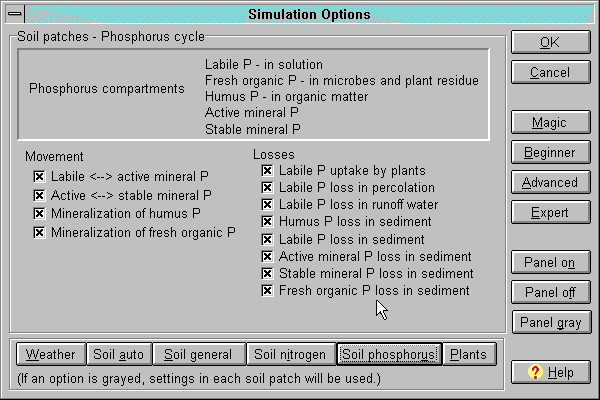Garden with Insight v1.0 Help: Simulation options window: soil phosphorus panel
In the simulation options window, the soil phosphorus panel contains
the following items. Click on the Soil phosphorus button at the bottom of the window to see the
soil phosphorus panel.
The check boxes in the Soil phosphorus panel control whether various processes are carried out by the model every day of the simulation. If an option is
checked, the process is turned ON for all soil patches, overriding any individual settings.
This is the default when you create a new garden. If an option is unchecked, the process
is turned OFF for all soil patches. If an option is grayed (filled in but
not checked), settings in individual soil patches are used for the option. You can change options for
individual soil patches in the browser (see the Soil params options group). By default each soil patch has
all processes turned on when it is created.
Movement
Labile <> active mineral P: Allow flow from labile to active mineral P. An equilibrium equation
based on the P sorption coefficient (PSP): the fraction of new labile P that tends to remain labile after an
initial rapid sorption phase. PSP depends on pH and soil weathering. [how
labile-active mineral P flow works]
Active <> stable mineral P: Allow flow from active to stable mineral phosphorus. An
equilibrium equation based on the assumption that at equilibrium there is four times as much stable as
active mineral P. The flow rate is affected by the amount of soil weathering. [how active-stable mineral P flow works]
Mineralization of humus P: Allow mineralization of organic phosphorus to labile phosphorus
(by soil microbes). Depends on the same factors as does active humus nitrogen mineralization -- uses the
same equation. [how mineralization of humus P works]
Mineralization of fresh organic P: Allow mineralization of fresh organic phosphorus (by
microbes). Depends on soil water, temperature, and C:N and C:P ratios in flat residue. 80% of
mineralized fresh organic P goes into labile P and 20% returns to humus P as dead microbial biomass.
[how mineralization of fresh organic P works]
Losses
Labile P uptake by plants: Allow plants to absorb labile phosphorus from the soil.
Labile P loss in percolation: Allow phosphorus leaching (as labile P) in water that percolates downward
through the soil. [how labile P allocation to plants works]
Labile P loss in runoff water: Allow phosphorus leaching (as labile P) in water that runs off the
soil surface. [how labile P loss in runoff water works]
Humus P loss in sediment: Remove a quantity of humus phosphorus from the first soil layer
proportional to the amount of soil lost from that layer during erosion. [how
nutrient loss in sediment works]
Labile P loss in sediment: Remove a quantity of labile phosphorus from the first soil layer
proportional to the amount of soil lost from that layer during erosion.
Active mineral P loss in sediment: Remove a quantity of active mineral phosphorus from the
first soil layer proportional to the amount of soil lost from that layer during erosion.
Stable mineral P loss in sediment: Remove a quantity of stable mineral phosphorus from the first
soil layer proportional to the amount of soil lost from that layer during erosion. (This is not in EPIC and
was added by us.)
Fresh organic P loss in sediment: Remove a quantity of fresh organic phosphorus from the first
soil layer proportional to the amount of soil lost from that layer during erosion. (This is not in EPIC and
was added by us.)

The simulation options window with soil phosphorus panel
| 
